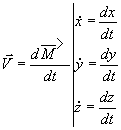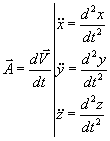| bibliography | introduction | 2D curves | Back to homepage | surfaces | fractals | polyhedra |
3D CURVES, or "skew" curves
|
|
|
|
|
|
|
BALL (SEAM LINE OF THE TENNIS/)
CURVATURE (CURVE OF CONSTANT/)
EDGE OF A DEVELOPABLE RULED SURFACE (CUSPIDAL/)
ENVELOPE OF A FAMILY OF CURVE WITH ONE PARAMETER
HELIX OF THE PARABOLOID OF REVOLUTION
HYPOCYCLOID (SPHERICAL/)
INDICATRIX OF CURVATURE
OF A 3D CURVE (SPHERICAL/)
INDICATRIX OF TORSION OF A 3D CURVE (SPHERICAL/)
JACOB LADDER
LIFT OF A PLANAR CURVE ON A SURFACE
LINE
ASYMPTOTIC/,
CURVATURE/,
GEODESIC/,
PSEUDOGEODESIC/
LINE (TOPOGRAPHIC/):
CONTOUR/,
CREST/,
SLOPE/,
THALWEG/
PENDULUM (CURVE OF THE SPHERICAL/)
PIRONDINI (CONICAL SPIRAL OF/)
PRECESSION (CURVE OF CONSTANT/)
RINGS (BORROMEAN/)
SALKOWSKI CURVE
SEIFFERT (SPHERICAL SPIRAL OF/)
SLOPE LINE (or LINE OF MAXIMAL SLOPE)
SPINNING-TOP (FESTOON OF THE/)
STRICTION LINE OF A NON DEVELOPABLE RULED SURFACE
TENNIS BALL (SEAM LINE OF THE/)
TRACTORY
:
curve under consideration.
M: current point on the curve.
direct orthonormal frame, with axes Ox , Oy and Oz.
:
Cartesian coordinates of M.
:
cylindrical coordinates of M;
![]() .
.
or
: spherical
coordinates of M (
is the longitude,
is the latitude and
the colatitude).
 ,
speed vector, V: algebraic speed.
,
speed vector, V: algebraic speed.
 ,
acceleration vector.
,
acceleration vector.
(T): tangent, supported by .
(P): osculating plane, supported by
and
.
(N): principal normal, orthogonal to (T), in the osculating plane.
(B): binormal, orthogonal to (P), supported
by .
s: curvilinear abscissa
(![]() ,
, ![]() )
)
(see also this page for the curvilinear abscissa traced on a surface)
![]() :
tangent (unit) vector.
:
tangent (unit) vector.
V: absolute speed ().
:
normal (unit) vector, supports the principal normal; the plane (M,
![]() ,
,![]() )
is the osculating plane at M.
)
is the osculating plane at M.
![]() :
center of curvature at M.
:
center of curvature at M.
![]() :
binormal vector =
:
binormal vector = ![]() (unit) (
(unit) ( = base,
or Frenet trihedron).
:
radius of curvature, always nonnegative.
![]() is the angle between
is the angle between ![]() and
and ![]() , thus
between two infinitely close tangents; j is
the angle of curvature; it represents the length of the path on which travels
the end of the tangent vector attached to a fixed point.
, thus
between two infinitely close tangents; j is
the angle of curvature; it represents the length of the path on which travels
the end of the tangent vector attached to a fixed point.
:
radius of torsion of a skew curve.
,
defined by
![]() is the angle between two infinitely close osculating planes; the sign convention
we used, called Darboux convention, is such that the right-handed
curves have a positive torsion; its sign does not depend on the travel
sense along the curve;
is the angle between two infinitely close osculating planes; the sign convention
we used, called Darboux convention, is such that the right-handed
curves have a positive torsion; its sign does not depend on the travel
sense along the curve;
is the torsion angle; it represents the length of the path on which travels
the end of the binormal vector attached to a fixed point.
We have the Frenet formulas:![]() ,
, ![]() ,
, ![]() .
.
: curvature ; (
measures the intensity of the variation of the tangente) .
: torsion (
measures the intensity of the variation of the osculating plane).
Hence the condensed writing of Frenet formulas: .
Cartesian system of equations, parametrization: characterization in terms of x, y and z.
Cylindrical system of equations, parametrization: characterization
in terms of ,
and
z.
Spherical system of equations, parametrization: characterization
in terms of r, and
.
See the notations for curves traced on a surface on the
page
dealing with surfaces.
| bibliography | introduction | 2D curves | Back to homepage | surfaces | fractals | polyhedra |